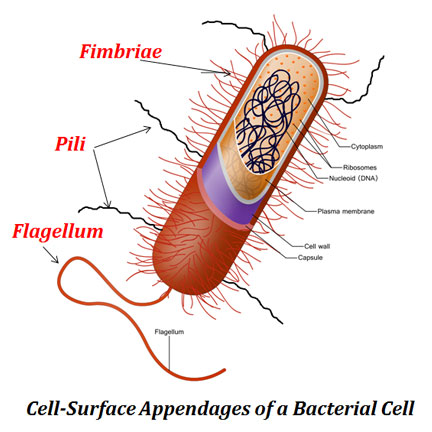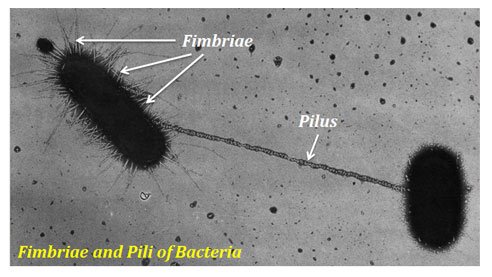Fimbriae vs Pili
Difference between Pili and Fimbriae: Both Fimbria (plural Fimbriae) and Pilus (plural Pili) are the filamentous proteinaceous structures found on the surface of some bacterial cells. They extend from the surface of the bacterial cell wall and can have many functions such as attachment, adhesion and assisting in genetic exchange.
Fimbriae definition: Fimbriae are bristle like short fibres occurs on the surface of some Gram positive and Gram negative bacteria. Fimbriae enable the bacterial cell to stick to the surface of host cells. They also help in the formation of pellicles or biofilms. (Pellicle: thin sheet of cells on the surface of a liquid).
Pili definition: Pili are long hair like tubular micro-fibres like structures present on the surface of some Gram negative bacteria. They are comparatively longer filamentous structures and their number per cell is very limited. There are many classes of pili based on their structure and function. Most of the pili can act as the receptors of some viruses.
The term Pili and Fimbriae are used inter-changeably by many authors in many microbiology text books. However, modern studies have clearly shown that they are two different entities in the bacteria distinguished by their development, structure and functions.
The present post describes the Similarities and Differences between Fimbriae and Pili with a Comparison Table
Similarities between Fimbriae and Pili
Ø Both fimbriae and pili are filamentous structures.
Ø Both are cell surface appendages, present on the cell surface of bacteria.
Ø Both are the attachment or adhesion organs in bacteria.
Ø Both are made up of proteins.
| You may also like NOTES in... | ||
|---|---|---|
| BOTANY | BIOCHEMISTRY | MOL. BIOLOGY |
| ZOOLOGY | MICROBIOLOGY | BIOSTATISTICS |
| ECOLOGY | IMMUNOLOGY | BIOTECHNOLOGY |
| GENETICS | EMBRYOLOGY | PHYSIOLOGY |
| EVOLUTION | BIOPHYSICS | BIOINFORMATICS |
Ø Both fimbriae and pili are visible under electron microscope.
Ø Both fimbriae and pili are antigenic and can evoke the immune response in the host.

Difference between Fimbriae and Pili
Sl. No. Fimbriae Pili
1 Fimbriae are bristle like short fibres occurs on the surface of bacteria. Pili are long hair like tubular microfibres like structures present on the surface of bacteria.
2 Fimbriae are present on both Gram positive and Gram negative bacteria. Pili are present only on some Gram negative bacteria.
3 Examples of bacteria having fimbriae
Salmonella typhimurium, Shigella dysenteriae.
Examples of bacteria having pili
Escherichia coli, Neisseria gonorrhoeae, Pseudomonas.
4 Fimbriae are made up of fimbrillin protein. Pili are made up of pilin protein.
5 Fimbriae are comparatively shorter in length than pili. Pili are comparatively longer than fimbriae.
6 Approximate length of fimbriae is 0.03 to 0.14 µm. Approximate length of pili is 0.5 – 2 µm.
7 Fimbriae are evenly distributed on the entire surface of the cell. Pili are randomly distributed on surface of the cell.
8 The total number of fimbriae per cell may range 200 – 400. Number of pili per cell is very less. It is usually 1 – 10 per cells.
9 The formation of fimbriae is controlled by the genes present in the nucleoid region of bacteria. The formation of pili is controlled by the gene present in plasmids.
10 Fimbriae are a solid structure. Pili are hollow tubular structures.
11 The fimbriae are comparatively thinner in their diameter. Pili are thicker than fimbriae. Their diameter ranges from 5 – 7.
12 Fimbriae are less rigid structures than pili. Pili are more rigid than fimbriae.
13 The main function of fimbriae is surface attachment. The main function of pili is gene transfer (by conjugation) and attachment.
14 Fimbriae do not have any role in bacterial mobility. Some pili such as Type IV pili show the twitching type of mobility.
15 Fimbriae are not reported to act as receptors for viruses. The majority of pili can act as the receptors for some virus.
16 No role in bacterial conjugation. A special type of pili called sex pili facilitates bacterial conjugation.

